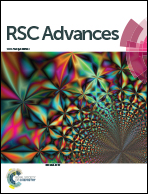Fabrication of magnetite nanoparticle doped reduced graphene oxide grafted polyhydroxyalkanoate nanocomposites for tissue engineering application†
Abstract
In tissue engineering, magnetic nanoparticle based polymeric nanocomposites are attractive due to some superior properties that are demonstrated in monitoring the nature of cell proliferation, differentiation and the activation of cell construction in the tissue regeneration phase. Herein, we have developed a non-toxic, antimicrobial, biocompatible and biodegradable magnetic Fe3O4/RGO-g-PHBV composite based porous 3D scaffold. The facile and cost-effective green pathways were chosen to reduce the exfoliated graphite oxide using a new microbial strain, Lysinibacillus fusiformis at room temperature. The reduction of exfoliated graphite oxide and the fabrication of iron nanoparticle embedded Fe3O4/RGO-g-PHBV nanocomposite were confirmed by X-ray powder diffraction (XRD), X-ray Photoelectron Spectroscopy (XPS) and Fourier transform infrared spectroscopy (FTIR). The analysis of the stretching vibrations by Raman spectroscopy indicated that both the graphite oxide and reduced graphene oxide exhibit frequencies at nearly 1560 cm−1 (G-band) and 1307 cm−1 (D-band). Field Emission Scanning Electron Microscopy (FESEM) and high-resolution transmission electron microscopic studies demonstrated the exfoliated nano sheets of the graphite oxide and the uniform distribution of the deposited ferrite nanoparticles. The inclusion of magnetite nanoparticles and reduced graphene oxide in the network of the PHBV matrix revealed the improvement of the mechanical strength of the nanocomposite, in comparison to the pure PHBV copolymer. The magnetic properties measured by vibrating sample magnetometer (VSM) and magnetic imaging resonance (MRI) confirmed the super-paramagnetic behavior of the nanocomposite, evidenced by the saturation magnetization having low coercive field and dark contrast images in the presence of applied magnetic fields. The confocal and scanning electron microscopy analyses demonstrated the excellent fibroblast cell infiltration, adhesion and proliferation into the micro-porous 3D scaffold, indicating the biocompatibility of the Fe3O4/RGO-g-PHBV nanocomposite based supporting biomaterials.


 Please wait while we load your content...
Please wait while we load your content...